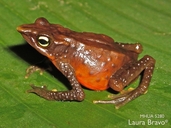|
Atelopus nocturnus Bravo-Valencia & Rivera-Correa, 2011
Nocturnal Harlequin Toad | family: Bufonidae genus: Atelopus |
| Species Description: Bravo-Valencia L, Rivera-Correa M. 2011. A new species of harlequin frog (Bufonidae: Atelopus) with an unusual behavior from Andes of Colombia. Zootaxa 3045:57-67. | |
 © 2013 Mauricio Rivera Correa (1 of 1) |
|
|
|
Description DIAGNOSIS: Atelopus nocturnus can be differentiated from similar Atelopus species by its moderate size, short hind limbs, pointed snout that protrudes beyond the lower jaw, absent tympanum and tympanic annulus, scattered warts on the dorsum, white pointed projections on warts of the arms and postocular region, apparent postorbital crest and vertebral neural processes, skin coloration, and bright yellow irises with black and brown spots (Bravo-Valencia and Rivera-Correa 2011). COLORATION: In life, female A. nocturnus have a dark reddish brown dorsum, with flank color transitioning from brown to orange. Males are dark brown on the dorsum and flank surfaces. The ventral surface of the body and limbs is bright orange in females, while males are white to yellowish cream-colored with irregular stripes and blotches of dark brown. The palmer hand and plantar in all individuals are orange, but with darker coloring in females. Both sexes have fingers I and toes I and II that are pale yellow, as well as bright yellow irises with brown spots and fine black reticulation. When preserved, the reddish hue of the female dorsum is lost and becomes dark brown. Any orange color, including on the ventral surface and flanks of the body in females and on the hands and feet in both sexes, turns cream in preservative along with the dorsal surfaces of fingers I and toes I and II. The white pointed projections on warts and outer metatarsal tubercle also turn cream in preservative (Bravo-Valencia and Rivera-Correa 2011). VARIATION: In addition to coloration, A. nocturnus exhibits sexual dimorphism in size as females are larger than males. Furthermore, the forearm is swollen and nuptial pads cover the dorsum of finger I in males. There is variation in the density of the warts on the dorsum flanks, and postocular region in females. In two male paratopotypes, the tops of the snouts are angled anteroventrally in lateral view (Bravo-Valencia and Rivera-Correa 2011). Distribution and Habitat Country distribution from AmphibiaWeb's database: Colombia
Life History, Abundance, Activity, and Special Behaviors It is likely that A. nocturnus breed in the dry season as females were found with small white ova and males had nuptial excrescences during that season. They have axillary amplexus (Bravo-Valencia and Rivera-Correa 2011). The reproductive behavior and larvae development is unknown, but other species in the genus Atelopus are observed to lay white eggs in strings underneath rock in shallow water (Starrett 1967). The nutrition and predation of A. nocturnus is unknown as well, but other species in the same genus have been observed to feed on small arthropods such as ants and beetles (Crump 1988). Trends and Threats Possible reasons for amphibian decline Disease Comments Phylogenetic Relationships: Atelopus nocturnus is not classified to any phenetic group because the phylogenetic analysis of genus Atelopus is mainly dependent on appearance. Without further phylogenetic analysis, it is not sufficient to support the phylogenetic relationship of the species (Bravo-Valencia and Rivera-Correa 2011).ETYMOLOGY: The species epithet is a reference to the nocturnal activity of A. nocturnus, from the Latin adjective “nocturnus.” At the time of its description, it was the only known nocturnal species in the genus Atelopus (Bravo-Valencia and Rivera-Correa 2011).
References
Bravo-Valencia, L., Rivera-Correa, M. (2011). “A new species of harlequin frog (Bufonidae: Atelopus) with an unusual behavior from Andes of Colombia.” Zootaxa, 3045, 57–67. [link] Crump, M.L. (1988). ''Aggression in Harlequin Frogs: male-male competition and a possible conflict of interest between the sexes.'' Animal Behaviour, 36(4), 1064-1077. IUCN SSC Amphibian Specialist Group. (2017). "Atelopus nocturnus". The IUCN Red List of Threatened Species 2017: e.T21567292A21567295. https://dx.doi.org/10.2305/IUCN.UK.2017-3.RLTS.T21567292A21567295.en. Downloaded on 19 February 2021. Starrett, P. (1967). ''Observations on the life history of frogs of the family Atelopodidae.'' Herpetologica, 23(3), 195-204. Originally submitted by: Hannah Blank, Karen Huizar Torres, Zita Gao (2021-08-06) Description by: Hannah Blank, Karen Huizar Torres, Zita Gao (updated 2021-08-06)
Distribution by: Hannah Blank, Karen Huizar Torres, Zita Gao (updated 2021-08-06)
Life history by: Hannah Blank, Karen Huizar Torres, Zita Gao (updated 2021-08-06)
Trends and threats by: Hannah Blank, Karen Huizar Torres, Zita Gao (updated 2021-08-06)
Comments by: Hannah Blank, Karen Huizar Torres, Zita Gao (updated 2021-08-06)
Edited by: Ann T. Chang (2021-08-06) Species Account Citation: AmphibiaWeb 2021 Atelopus nocturnus: Nocturnal Harlequin Toad <https://amphibiaweb.org/species/7725> University of California, Berkeley, CA, USA. Accessed Jul 26, 2024.
Feedback or comments about this page.
Citation: AmphibiaWeb. 2024. <https://amphibiaweb.org> University of California, Berkeley, CA, USA. Accessed 26 Jul 2024. AmphibiaWeb's policy on data use. |


 Map of Life
Map of Life